Business Law: Analysis of Gumland Property Holdings and East v Maurer
VerifiedAdded on 2023/06/05
|13
|2122
|439
Case Study
AI Summary
This case study delves into two distinct legal scenarios within the realm of business law. The first part analyzes Gumland Property Holdings Pty Limited v Duffy Bros Fruit Market (Campbelltown) Pty limited, focusing on the termination of a commercial lease due to the lessee's failure to pay rent following the expiration of a sub-lease. It examines the tenant's obligations under a commercial lease and the consequences of non-compliance, particularly concerning sub-leases. The second part scrutinizes East v Maurer, addressing fraudulent misrepresentation in contract law. It discusses the elements of fraudulent misrepresentation, available remedies, and the implications under Australian Consumer Law, highlighting the rights of the aggrieved party and the potential for damages or rescission of the contract. Desklib provides students access to similar solved assignments and past papers.
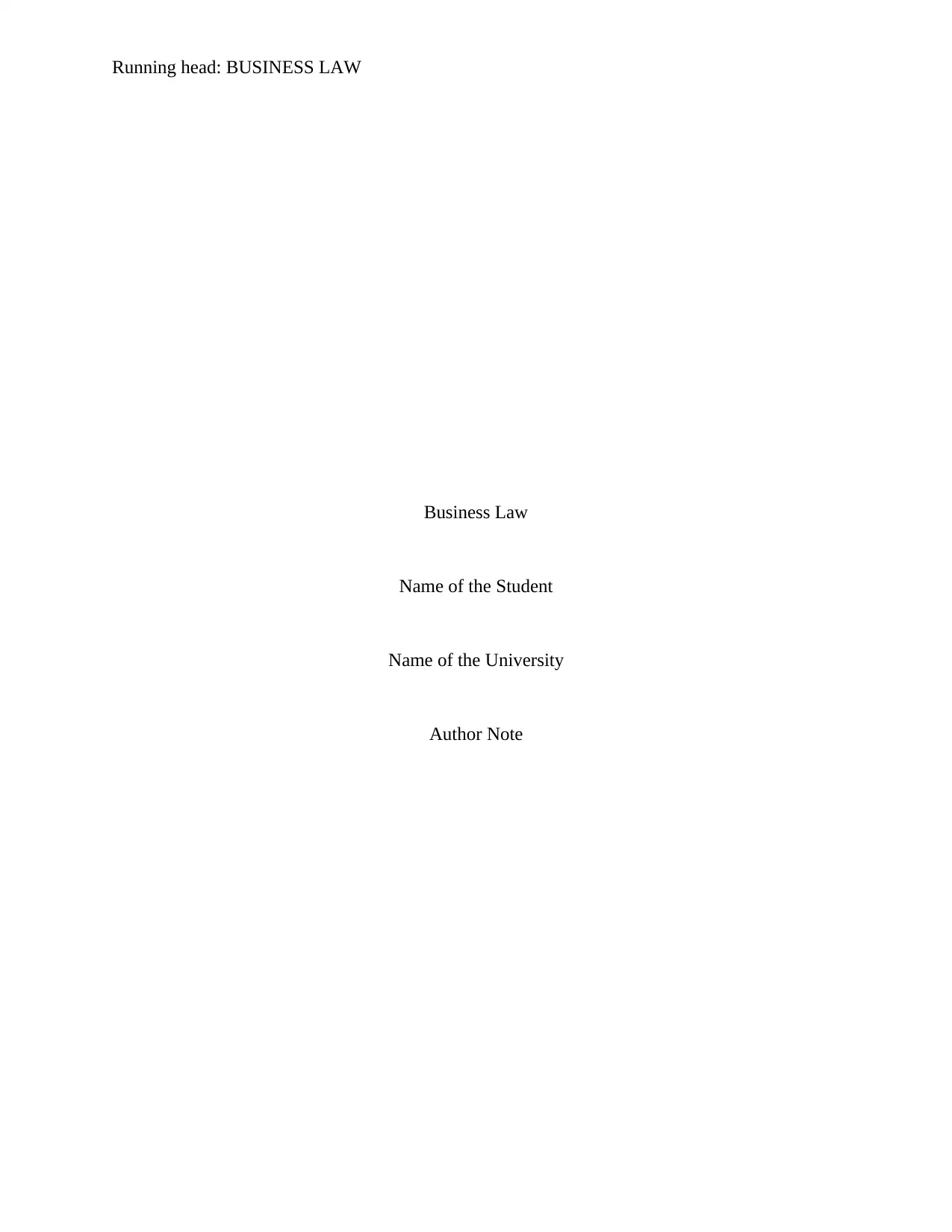
Running head: BUSINESS LAW
Business Law
Name of the Student
Name of the University
Author Note
Business Law
Name of the Student
Name of the University
Author Note
Paraphrase This Document
Need a fresh take? Get an instant paraphrase of this document with our AI Paraphraser
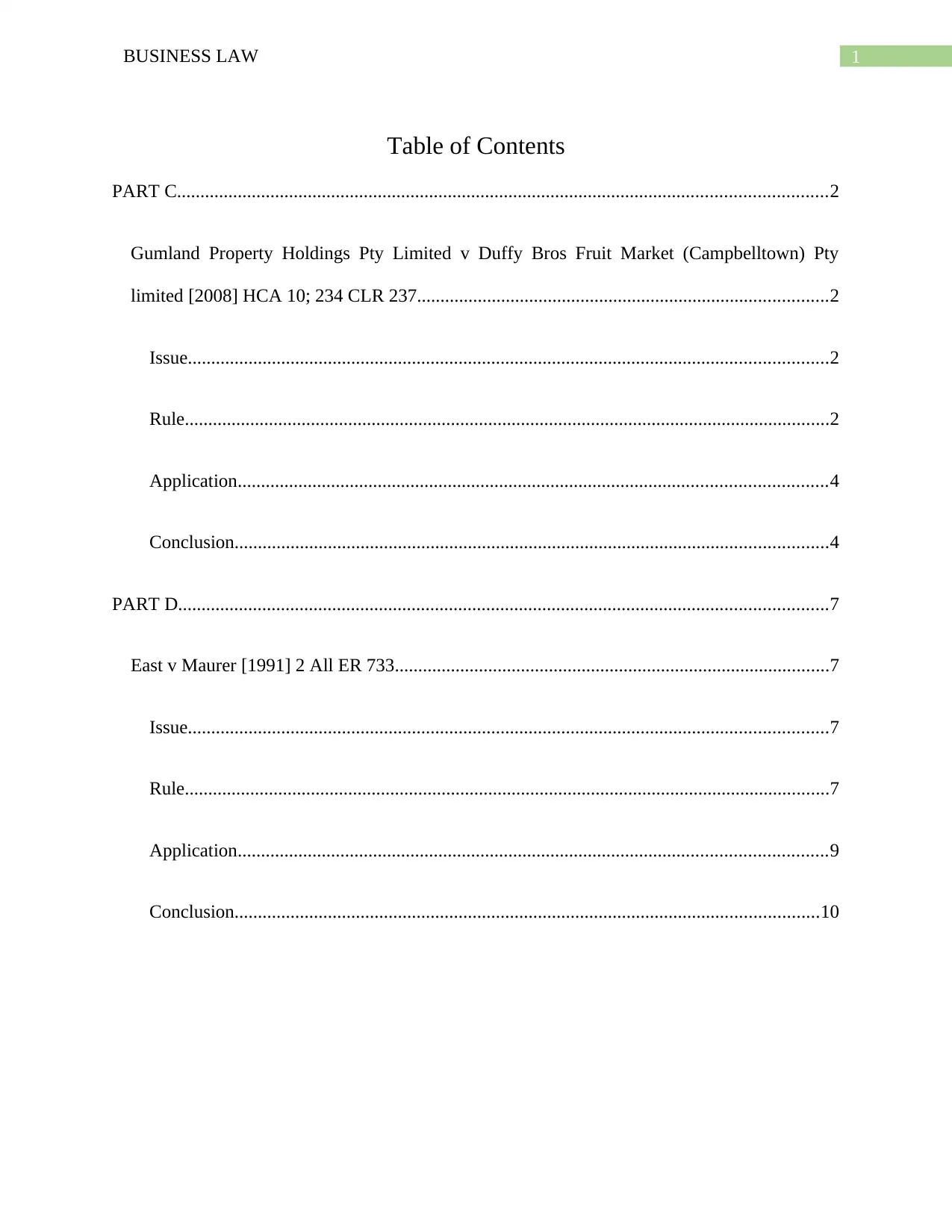
1BUSINESS LAW
Table of Contents
PART C...........................................................................................................................................2
Gumland Property Holdings Pty Limited v Duffy Bros Fruit Market (Campbelltown) Pty
limited [2008] HCA 10; 234 CLR 237........................................................................................2
Issue.........................................................................................................................................2
Rule..........................................................................................................................................2
Application..............................................................................................................................4
Conclusion...............................................................................................................................4
PART D...........................................................................................................................................7
East v Maurer [1991] 2 All ER 733.............................................................................................7
Issue.........................................................................................................................................7
Rule..........................................................................................................................................7
Application..............................................................................................................................9
Conclusion.............................................................................................................................10
Table of Contents
PART C...........................................................................................................................................2
Gumland Property Holdings Pty Limited v Duffy Bros Fruit Market (Campbelltown) Pty
limited [2008] HCA 10; 234 CLR 237........................................................................................2
Issue.........................................................................................................................................2
Rule..........................................................................................................................................2
Application..............................................................................................................................4
Conclusion...............................................................................................................................4
PART D...........................................................................................................................................7
East v Maurer [1991] 2 All ER 733.............................................................................................7
Issue.........................................................................................................................................7
Rule..........................................................................................................................................7
Application..............................................................................................................................9
Conclusion.............................................................................................................................10

2BUSINESS LAW
⊘ This is a preview!⊘
Do you want full access?
Subscribe today to unlock all pages.

Trusted by 1+ million students worldwide
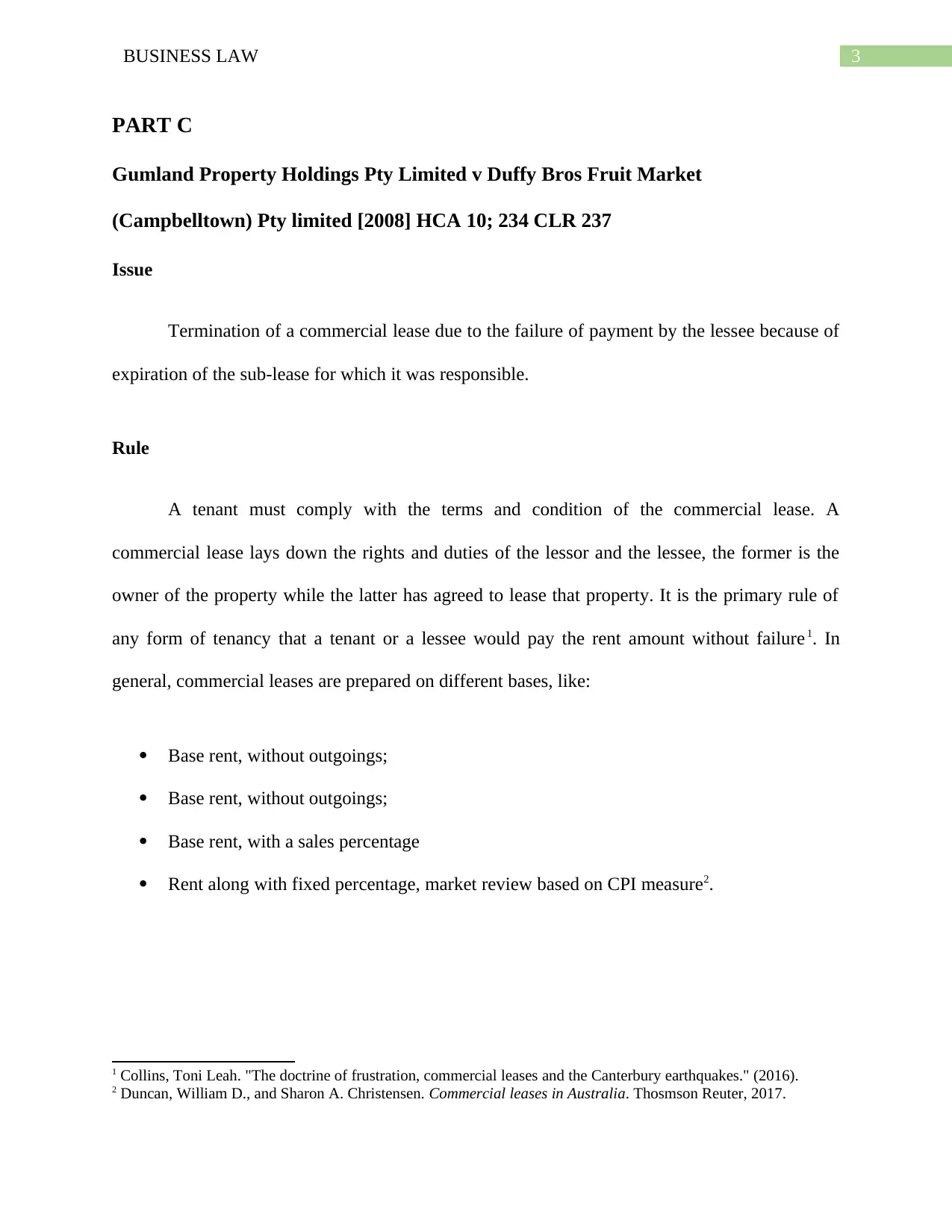
3BUSINESS LAW
PART C
Gumland Property Holdings Pty Limited v Duffy Bros Fruit Market
(Campbelltown) Pty limited [2008] HCA 10; 234 CLR 237
Issue
Termination of a commercial lease due to the failure of payment by the lessee because of
expiration of the sub-lease for which it was responsible.
Rule
A tenant must comply with the terms and condition of the commercial lease. A
commercial lease lays down the rights and duties of the lessor and the lessee, the former is the
owner of the property while the latter has agreed to lease that property. It is the primary rule of
any form of tenancy that a tenant or a lessee would pay the rent amount without failure 1. In
general, commercial leases are prepared on different bases, like:
Base rent, without outgoings;
Base rent, without outgoings;
Base rent, with a sales percentage
Rent along with fixed percentage, market review based on CPI measure2.
1 Collins, Toni Leah. "The doctrine of frustration, commercial leases and the Canterbury earthquakes." (2016).
2 Duncan, William D., and Sharon A. Christensen. Commercial leases in Australia. Thosmson Reuter, 2017.
PART C
Gumland Property Holdings Pty Limited v Duffy Bros Fruit Market
(Campbelltown) Pty limited [2008] HCA 10; 234 CLR 237
Issue
Termination of a commercial lease due to the failure of payment by the lessee because of
expiration of the sub-lease for which it was responsible.
Rule
A tenant must comply with the terms and condition of the commercial lease. A
commercial lease lays down the rights and duties of the lessor and the lessee, the former is the
owner of the property while the latter has agreed to lease that property. It is the primary rule of
any form of tenancy that a tenant or a lessee would pay the rent amount without failure 1. In
general, commercial leases are prepared on different bases, like:
Base rent, without outgoings;
Base rent, without outgoings;
Base rent, with a sales percentage
Rent along with fixed percentage, market review based on CPI measure2.
1 Collins, Toni Leah. "The doctrine of frustration, commercial leases and the Canterbury earthquakes." (2016).
2 Duncan, William D., and Sharon A. Christensen. Commercial leases in Australia. Thosmson Reuter, 2017.
Paraphrase This Document
Need a fresh take? Get an instant paraphrase of this document with our AI Paraphraser

4BUSINESS LAW
The tenants and landlord’s bargaining position determines the rental term of the lease.
Commercial lease can be entered into for 3 to 25 years along with an option and an initial term to
extend such lease3.
Sub-let or sub-lease is not allowed on a tenant’s or lessee’s part unless it is permitted by
the lessor under contract. Sub-lease enables a lessee to cut-down its operation when facing
financial downfall and it also gets financial help by sub-letting the premises. However, sub-lease
does not facilitate the lessee to evade its obligation pertaining to such sub-lease. It is to
remembered that a sub-let or sub-lease is mainly allowed for the benefit of the tenant or lessee,
therefore such tenant or lessee always holds certain liability for such sub-let or sub-lease.
therefore, on non-compliance of such lease or sub-lease, the lessor has the power to terminate
such agreement and sue the lessee4.
An assignment of a lease or sub-lease is the agreement between the lessee and a third
party, which confers the obligation of the lessee pertaining to the sub-lease or it forms a fresh
agreement involving the lessee and the third party5. This assignment may or may not be on the
same terms as the lease between the lessor and the lessee. Therefore, the lessee cannot abandon
or evade the terms of a lease on the basis of expiration of a sub-lease6.
Application
Pertaining the laws of tenancy and lease, Duffy Bros Fruit Market Pty Ltd (Duffy) was
held responsible for the non-compliance of the term of its agreement with the lessor. Duff was
3 Carter, John W. The construction of commercial contracts. Bloomsbury Publishing, 2013.
4 Carter, J. W. "Drafting termination clauses." Commercial Law Quarterly: The Journal of the Commercial Law
Association of Australia 31.1 (2017): 22.
5 Steiner, Beat U. "A Quick Review of a Commercial Lease." Prob. & Prop. 29 (2015): 48.
6 Goldberg, Richard R. "SUBLEASING AND ASSIGNMENTS, PART 1 & PART 2."
The tenants and landlord’s bargaining position determines the rental term of the lease.
Commercial lease can be entered into for 3 to 25 years along with an option and an initial term to
extend such lease3.
Sub-let or sub-lease is not allowed on a tenant’s or lessee’s part unless it is permitted by
the lessor under contract. Sub-lease enables a lessee to cut-down its operation when facing
financial downfall and it also gets financial help by sub-letting the premises. However, sub-lease
does not facilitate the lessee to evade its obligation pertaining to such sub-lease. It is to
remembered that a sub-let or sub-lease is mainly allowed for the benefit of the tenant or lessee,
therefore such tenant or lessee always holds certain liability for such sub-let or sub-lease.
therefore, on non-compliance of such lease or sub-lease, the lessor has the power to terminate
such agreement and sue the lessee4.
An assignment of a lease or sub-lease is the agreement between the lessee and a third
party, which confers the obligation of the lessee pertaining to the sub-lease or it forms a fresh
agreement involving the lessee and the third party5. This assignment may or may not be on the
same terms as the lease between the lessor and the lessee. Therefore, the lessee cannot abandon
or evade the terms of a lease on the basis of expiration of a sub-lease6.
Application
Pertaining the laws of tenancy and lease, Duffy Bros Fruit Market Pty Ltd (Duffy) was
held responsible for the non-compliance of the term of its agreement with the lessor. Duff was
3 Carter, John W. The construction of commercial contracts. Bloomsbury Publishing, 2013.
4 Carter, J. W. "Drafting termination clauses." Commercial Law Quarterly: The Journal of the Commercial Law
Association of Australia 31.1 (2017): 22.
5 Steiner, Beat U. "A Quick Review of a Commercial Lease." Prob. & Prop. 29 (2015): 48.
6 Goldberg, Richard R. "SUBLEASING AND ASSIGNMENTS, PART 1 & PART 2."
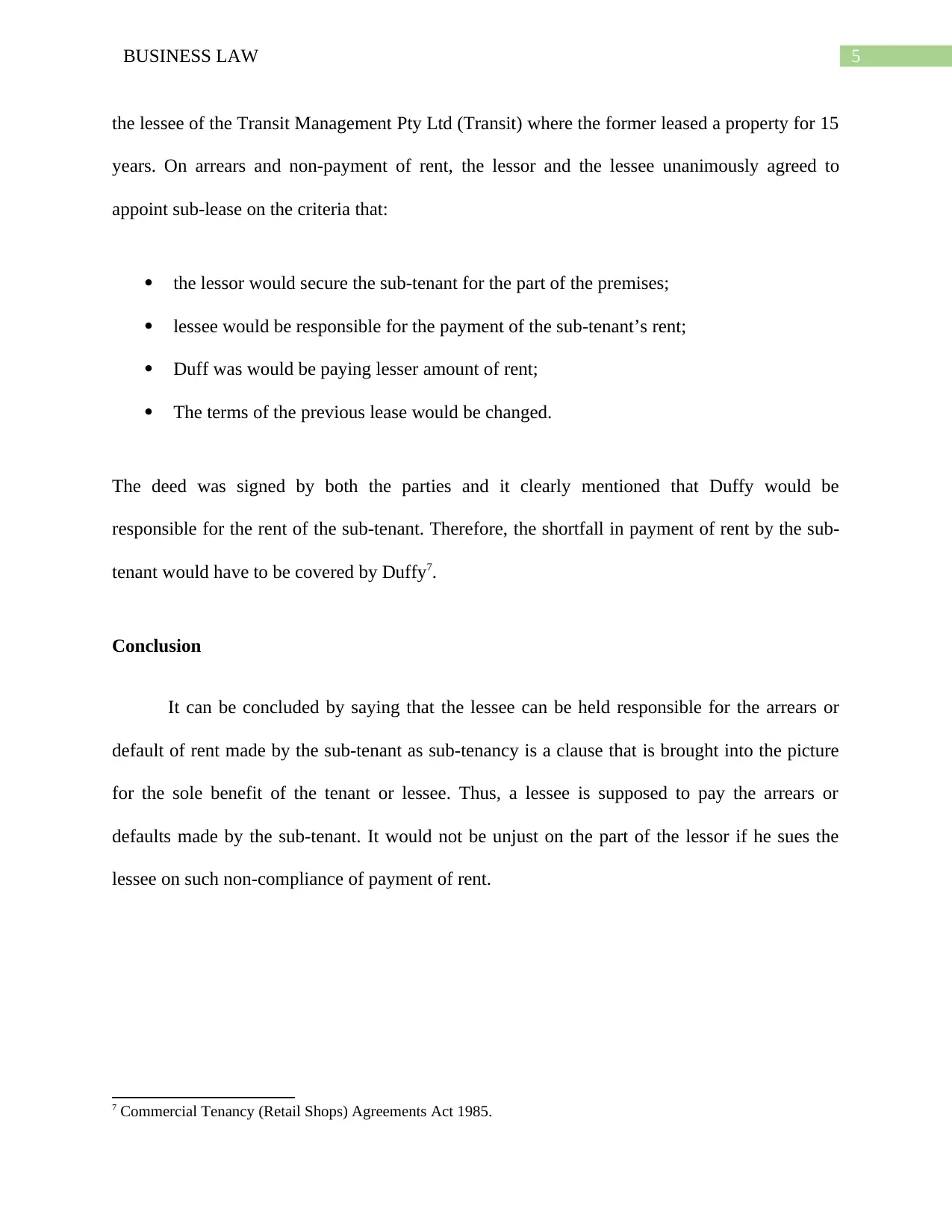
5BUSINESS LAW
the lessee of the Transit Management Pty Ltd (Transit) where the former leased a property for 15
years. On arrears and non-payment of rent, the lessor and the lessee unanimously agreed to
appoint sub-lease on the criteria that:
the lessor would secure the sub-tenant for the part of the premises;
lessee would be responsible for the payment of the sub-tenant’s rent;
Duff was would be paying lesser amount of rent;
The terms of the previous lease would be changed.
The deed was signed by both the parties and it clearly mentioned that Duffy would be
responsible for the rent of the sub-tenant. Therefore, the shortfall in payment of rent by the sub-
tenant would have to be covered by Duffy7.
Conclusion
It can be concluded by saying that the lessee can be held responsible for the arrears or
default of rent made by the sub-tenant as sub-tenancy is a clause that is brought into the picture
for the sole benefit of the tenant or lessee. Thus, a lessee is supposed to pay the arrears or
defaults made by the sub-tenant. It would not be unjust on the part of the lessor if he sues the
lessee on such non-compliance of payment of rent.
7 Commercial Tenancy (Retail Shops) Agreements Act 1985.
the lessee of the Transit Management Pty Ltd (Transit) where the former leased a property for 15
years. On arrears and non-payment of rent, the lessor and the lessee unanimously agreed to
appoint sub-lease on the criteria that:
the lessor would secure the sub-tenant for the part of the premises;
lessee would be responsible for the payment of the sub-tenant’s rent;
Duff was would be paying lesser amount of rent;
The terms of the previous lease would be changed.
The deed was signed by both the parties and it clearly mentioned that Duffy would be
responsible for the rent of the sub-tenant. Therefore, the shortfall in payment of rent by the sub-
tenant would have to be covered by Duffy7.
Conclusion
It can be concluded by saying that the lessee can be held responsible for the arrears or
default of rent made by the sub-tenant as sub-tenancy is a clause that is brought into the picture
for the sole benefit of the tenant or lessee. Thus, a lessee is supposed to pay the arrears or
defaults made by the sub-tenant. It would not be unjust on the part of the lessor if he sues the
lessee on such non-compliance of payment of rent.
7 Commercial Tenancy (Retail Shops) Agreements Act 1985.
⊘ This is a preview!⊘
Do you want full access?
Subscribe today to unlock all pages.

Trusted by 1+ million students worldwide
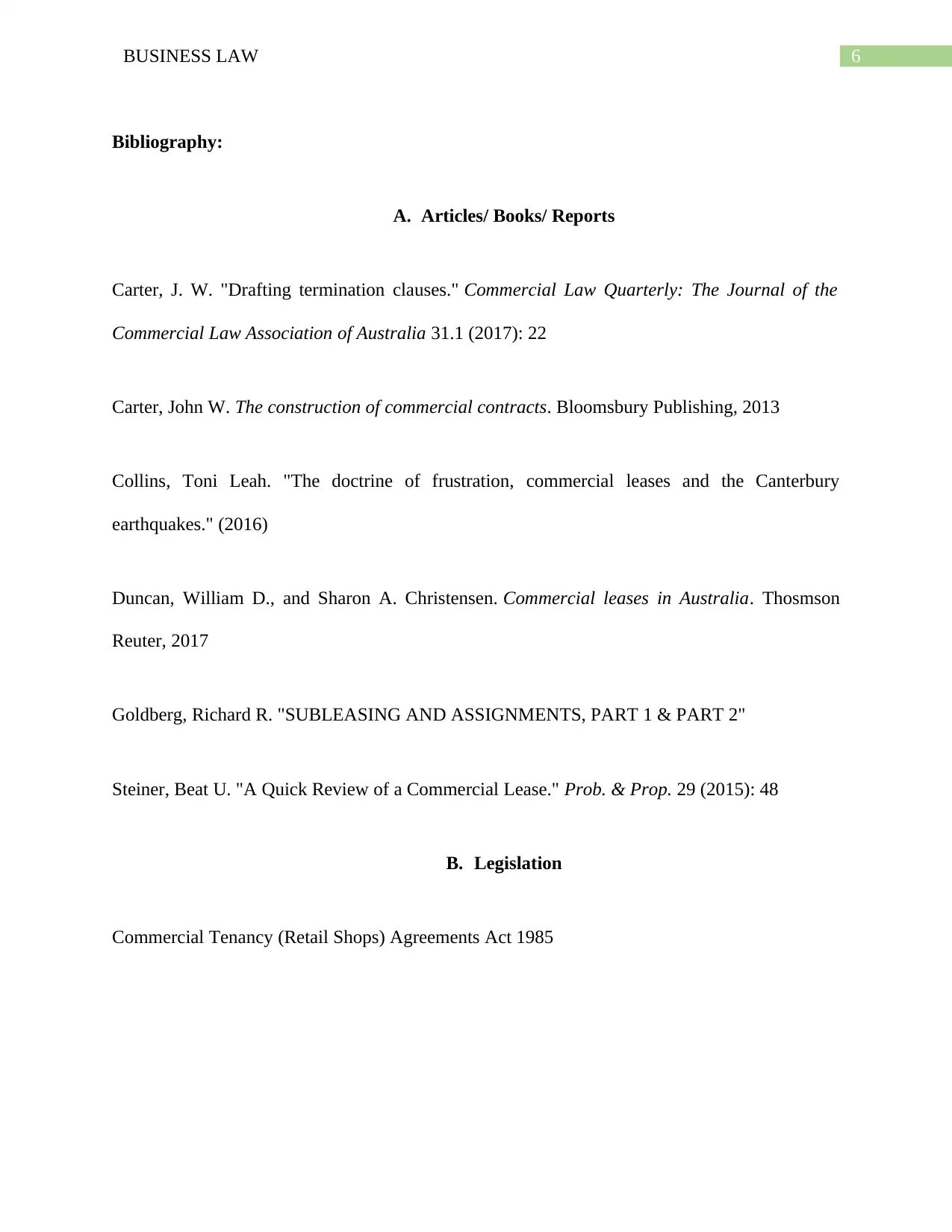
6BUSINESS LAW
Bibliography:
A. Articles/ Books/ Reports
Carter, J. W. "Drafting termination clauses." Commercial Law Quarterly: The Journal of the
Commercial Law Association of Australia 31.1 (2017): 22
Carter, John W. The construction of commercial contracts. Bloomsbury Publishing, 2013
Collins, Toni Leah. "The doctrine of frustration, commercial leases and the Canterbury
earthquakes." (2016)
Duncan, William D., and Sharon A. Christensen. Commercial leases in Australia. Thosmson
Reuter, 2017
Goldberg, Richard R. "SUBLEASING AND ASSIGNMENTS, PART 1 & PART 2"
Steiner, Beat U. "A Quick Review of a Commercial Lease." Prob. & Prop. 29 (2015): 48
B. Legislation
Commercial Tenancy (Retail Shops) Agreements Act 1985
Bibliography:
A. Articles/ Books/ Reports
Carter, J. W. "Drafting termination clauses." Commercial Law Quarterly: The Journal of the
Commercial Law Association of Australia 31.1 (2017): 22
Carter, John W. The construction of commercial contracts. Bloomsbury Publishing, 2013
Collins, Toni Leah. "The doctrine of frustration, commercial leases and the Canterbury
earthquakes." (2016)
Duncan, William D., and Sharon A. Christensen. Commercial leases in Australia. Thosmson
Reuter, 2017
Goldberg, Richard R. "SUBLEASING AND ASSIGNMENTS, PART 1 & PART 2"
Steiner, Beat U. "A Quick Review of a Commercial Lease." Prob. & Prop. 29 (2015): 48
B. Legislation
Commercial Tenancy (Retail Shops) Agreements Act 1985
Paraphrase This Document
Need a fresh take? Get an instant paraphrase of this document with our AI Paraphraser

7BUSINESS LAW
PART D
East v Maurer [1991] 2 All ER 733
Issue
Maurer falsely promised not to open a competing business when he sold one of his hair
salon to East. Yet, Maurer continued working on another salon owned by him. East sued Maurer
for fraud.
Rule
The law of Contract clearly states that a party must not enter into a contractual agreement
based on fraudulent clauses or misrepresentation. The party forming such fraudulent contract
shall be obliged to pay for damages in case of dispute8. Additionally, a contract based on
fraudulent misrepresentation is not valid unless all the parties to such contract agrees to continue
working under such fraudulent terms. If after the entering into such fraudulent contract, the other
party comprehends such fraud and misrepresentation, then the party has the right to sue the other
party. The elements of Fraudulent Misrepresentation are as follows9:
Representation was formed;
Such representation was false;
The defendant party entered into such fraudulent representation without knowing it to be
false or recklessly without knowing;
The defendant relied on such fraudulent representation; and
8 Stone, Richard, and James Devenney. The modern law of contract. Routledge, 2017.
9 Klement, Alon, Zvika Neeman, and Yuval Procaccia. "Consumer Fraud, Misrepresentation and
Reliance." International Review of Law and Economics 54 (2018): 95-105.
PART D
East v Maurer [1991] 2 All ER 733
Issue
Maurer falsely promised not to open a competing business when he sold one of his hair
salon to East. Yet, Maurer continued working on another salon owned by him. East sued Maurer
for fraud.
Rule
The law of Contract clearly states that a party must not enter into a contractual agreement
based on fraudulent clauses or misrepresentation. The party forming such fraudulent contract
shall be obliged to pay for damages in case of dispute8. Additionally, a contract based on
fraudulent misrepresentation is not valid unless all the parties to such contract agrees to continue
working under such fraudulent terms. If after the entering into such fraudulent contract, the other
party comprehends such fraud and misrepresentation, then the party has the right to sue the other
party. The elements of Fraudulent Misrepresentation are as follows9:
Representation was formed;
Such representation was false;
The defendant party entered into such fraudulent representation without knowing it to be
false or recklessly without knowing;
The defendant relied on such fraudulent representation; and
8 Stone, Richard, and James Devenney. The modern law of contract. Routledge, 2017.
9 Klement, Alon, Zvika Neeman, and Yuval Procaccia. "Consumer Fraud, Misrepresentation and
Reliance." International Review of Law and Economics 54 (2018): 95-105.

8BUSINESS LAW
The defendant suffered loss due to such fraudulent representation.
The remedies of fraudulent misrepresentation depends from case to case. It may attract
rescission of the fraudulent contract or it may also attract damages to the defendant, or
sometimes both. Fraudulent representation of a contract is necessarily not void rather it is
voidable in nature, which gives the aggrieved party to decide whether to continue with such
faulty contract.
While in terms of the Australian Consumer law (ACL):
Contracts cannot be unfair and unjust in terms of consumers and small businesses;
Consumers should be protected while they buy goods and services;
Penalties, enforcement and consumer redressal should be focused on10.
The ACL is applicable to all the Territories and States, and all businesses in Australia.
ACL is laid down and controlled by the Australian Competition and Consumer Commission
(ACCC) and the agencies of state and territory for protecting consumers11. The Competition and
Consumer Act 2010 (CCA) broadly throws light on the provisions of Trade Practices Act 1947
(TPA) and is an extension of it. The TPA strived to protect consumers and promote a healthy
competition between businesses. On a similar note, The ACL refrains businesses to put forward
fraudulent contract and mislead consumers or other businesses entering into a contract.
Therefore, the aggrieved party is eligible to claim damages under the Competition and Consumer
Act 2010.
10 Corones, Stephen G. Competition law in Australia. Thomson Reuters Australia, Limited, 2014.
11 Altman, Jon, and Sally Ward. "Competition and consumer issues for Indigenous Australians: A report to the
Australian Competition and Consumer Commission by the Centre for Aboriginal Economic Policy Research, the
Australian National University, Canberra." (2018).
The defendant suffered loss due to such fraudulent representation.
The remedies of fraudulent misrepresentation depends from case to case. It may attract
rescission of the fraudulent contract or it may also attract damages to the defendant, or
sometimes both. Fraudulent representation of a contract is necessarily not void rather it is
voidable in nature, which gives the aggrieved party to decide whether to continue with such
faulty contract.
While in terms of the Australian Consumer law (ACL):
Contracts cannot be unfair and unjust in terms of consumers and small businesses;
Consumers should be protected while they buy goods and services;
Penalties, enforcement and consumer redressal should be focused on10.
The ACL is applicable to all the Territories and States, and all businesses in Australia.
ACL is laid down and controlled by the Australian Competition and Consumer Commission
(ACCC) and the agencies of state and territory for protecting consumers11. The Competition and
Consumer Act 2010 (CCA) broadly throws light on the provisions of Trade Practices Act 1947
(TPA) and is an extension of it. The TPA strived to protect consumers and promote a healthy
competition between businesses. On a similar note, The ACL refrains businesses to put forward
fraudulent contract and mislead consumers or other businesses entering into a contract.
Therefore, the aggrieved party is eligible to claim damages under the Competition and Consumer
Act 2010.
10 Corones, Stephen G. Competition law in Australia. Thomson Reuters Australia, Limited, 2014.
11 Altman, Jon, and Sally Ward. "Competition and consumer issues for Indigenous Australians: A report to the
Australian Competition and Consumer Commission by the Centre for Aboriginal Economic Policy Research, the
Australian National University, Canberra." (2018).
⊘ This is a preview!⊘
Do you want full access?
Subscribe today to unlock all pages.

Trusted by 1+ million students worldwide

9BUSINESS LAW
In addition to the remedies under Contract law and Consumer law, the aggrieved party
can be brought under the Misrepresentation Act 1967 to award damages under the Common
Law12.
Application
In this case, East is the aggrieved party who entered into the fraudulent contract formed
by Maurer promising that he would not start or continue working on a competitive business,
which might hamper East’s business of hair salon that he bought from Maurer. Nevertheless,
Maurer already had another hair salon when he sold one to East. After such Sale, Maurer
continued with the other hair salon, defeating the profit of East’s business, giving it a heavy loss.
East has the right to sue Maurer on the grounds of fraudulent representation of contract.
However, East has the liberty to continue with the existing contract as it is a voidable contract.
East may pray to the Court of Law for rescinding the contract or may pray for damages or both.
The Court would rescind the contract on such prayer of the plaintiff. The Court would also award
damages to the aggrieved party for incurring such heavy loss due to the fraudulent
misrepresentation13.
From the Australian Consumer Law’s point of view, East is also a consumers as he has
bought the existing business of hair salon from Maurer. Therefore, East would also be protected
under Consumer Law.
12 Davies, Paul S. "RESCISSION FOR MISREPRESENTATION." The Cambridge Law Journal 75.1 (2016): 15-17.
13 Royscot Trust Ltd v Rogerson [1991] EWCA Civ 12
In addition to the remedies under Contract law and Consumer law, the aggrieved party
can be brought under the Misrepresentation Act 1967 to award damages under the Common
Law12.
Application
In this case, East is the aggrieved party who entered into the fraudulent contract formed
by Maurer promising that he would not start or continue working on a competitive business,
which might hamper East’s business of hair salon that he bought from Maurer. Nevertheless,
Maurer already had another hair salon when he sold one to East. After such Sale, Maurer
continued with the other hair salon, defeating the profit of East’s business, giving it a heavy loss.
East has the right to sue Maurer on the grounds of fraudulent representation of contract.
However, East has the liberty to continue with the existing contract as it is a voidable contract.
East may pray to the Court of Law for rescinding the contract or may pray for damages or both.
The Court would rescind the contract on such prayer of the plaintiff. The Court would also award
damages to the aggrieved party for incurring such heavy loss due to the fraudulent
misrepresentation13.
From the Australian Consumer Law’s point of view, East is also a consumers as he has
bought the existing business of hair salon from Maurer. Therefore, East would also be protected
under Consumer Law.
12 Davies, Paul S. "RESCISSION FOR MISREPRESENTATION." The Cambridge Law Journal 75.1 (2016): 15-17.
13 Royscot Trust Ltd v Rogerson [1991] EWCA Civ 12
Paraphrase This Document
Need a fresh take? Get an instant paraphrase of this document with our AI Paraphraser
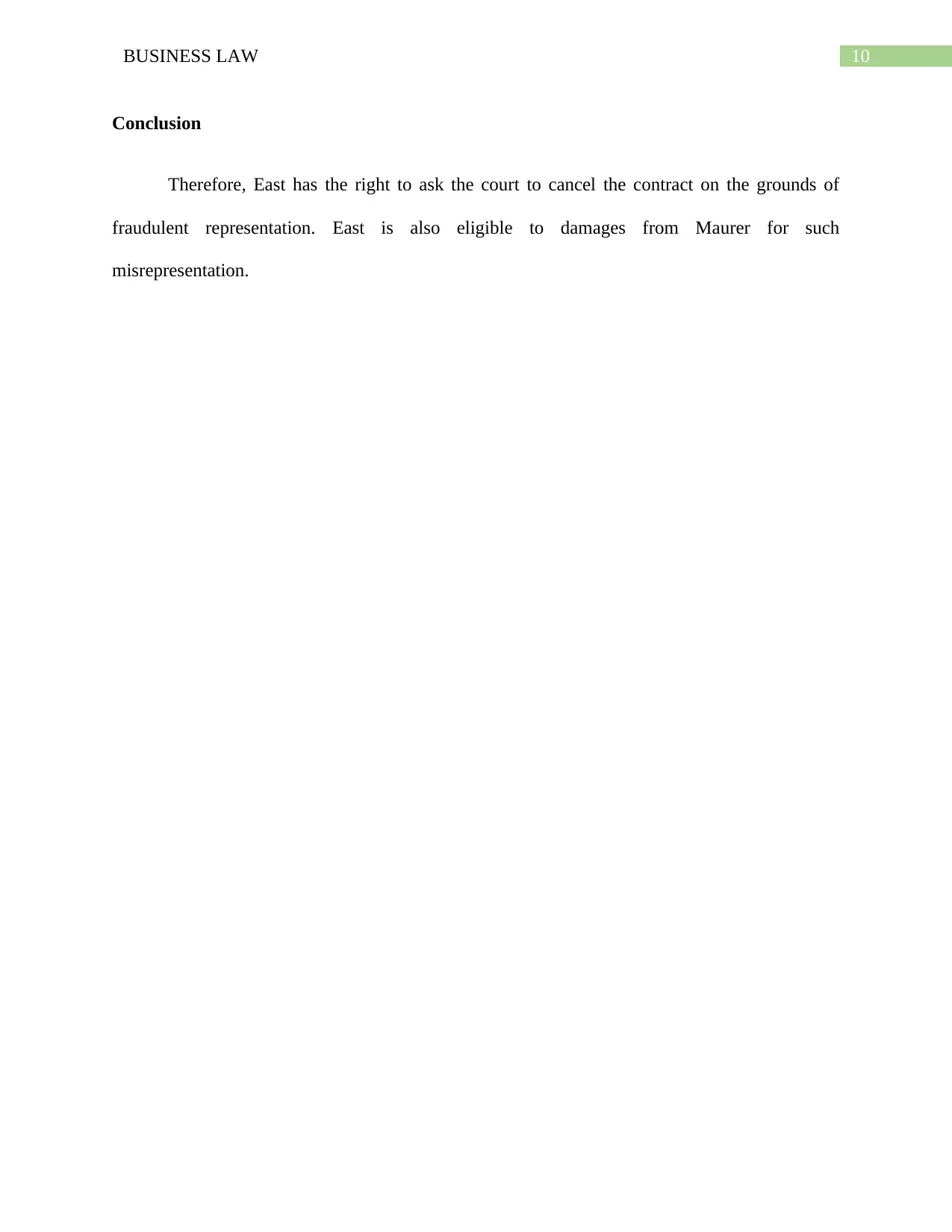
10BUSINESS LAW
Conclusion
Therefore, East has the right to ask the court to cancel the contract on the grounds of
fraudulent representation. East is also eligible to damages from Maurer for such
misrepresentation.
Conclusion
Therefore, East has the right to ask the court to cancel the contract on the grounds of
fraudulent representation. East is also eligible to damages from Maurer for such
misrepresentation.
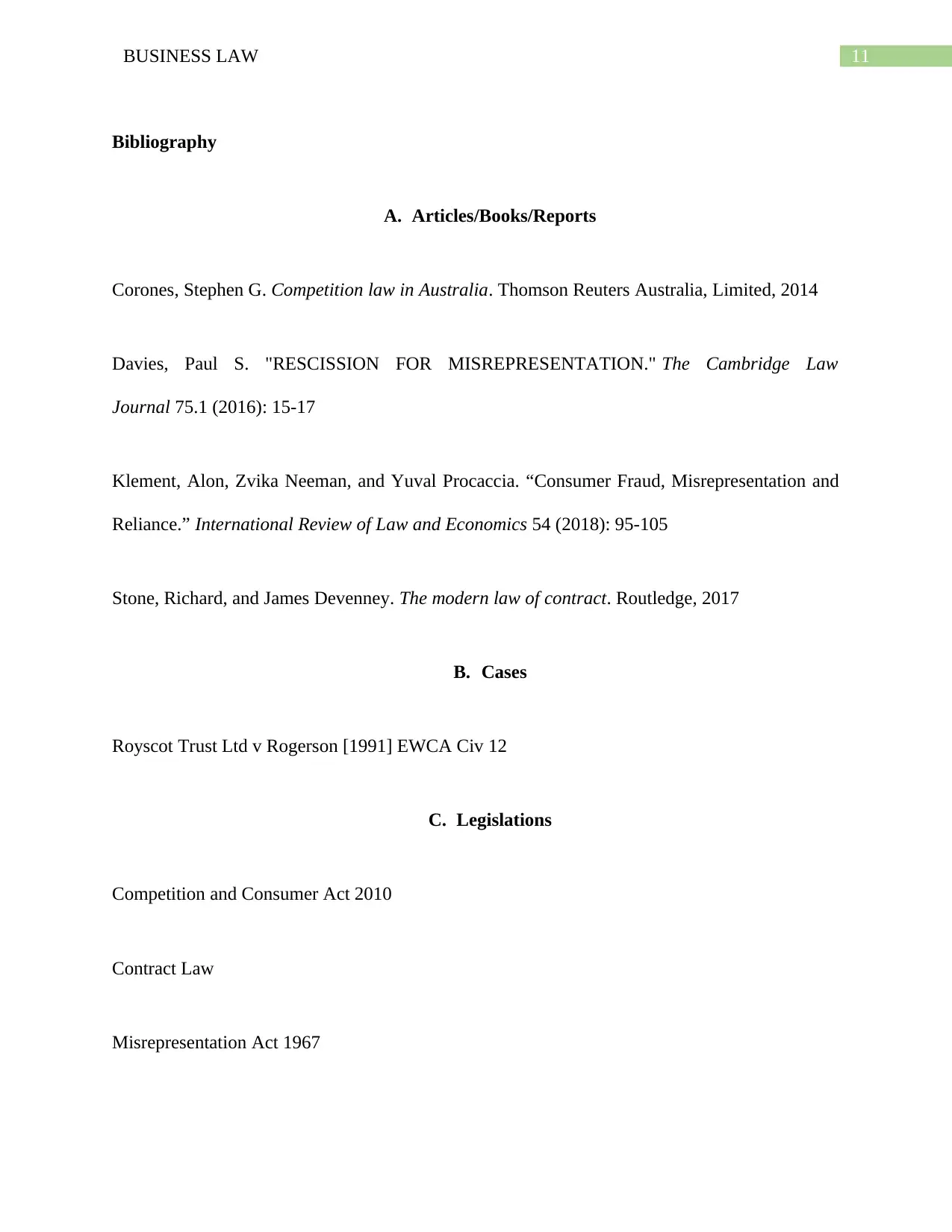
11BUSINESS LAW
Bibliography
A. Articles/Books/Reports
Corones, Stephen G. Competition law in Australia. Thomson Reuters Australia, Limited, 2014
Davies, Paul S. "RESCISSION FOR MISREPRESENTATION." The Cambridge Law
Journal 75.1 (2016): 15-17
Klement, Alon, Zvika Neeman, and Yuval Procaccia. “Consumer Fraud, Misrepresentation and
Reliance.” International Review of Law and Economics 54 (2018): 95-105
Stone, Richard, and James Devenney. The modern law of contract. Routledge, 2017
B. Cases
Royscot Trust Ltd v Rogerson [1991] EWCA Civ 12
C. Legislations
Competition and Consumer Act 2010
Contract Law
Misrepresentation Act 1967
Bibliography
A. Articles/Books/Reports
Corones, Stephen G. Competition law in Australia. Thomson Reuters Australia, Limited, 2014
Davies, Paul S. "RESCISSION FOR MISREPRESENTATION." The Cambridge Law
Journal 75.1 (2016): 15-17
Klement, Alon, Zvika Neeman, and Yuval Procaccia. “Consumer Fraud, Misrepresentation and
Reliance.” International Review of Law and Economics 54 (2018): 95-105
Stone, Richard, and James Devenney. The modern law of contract. Routledge, 2017
B. Cases
Royscot Trust Ltd v Rogerson [1991] EWCA Civ 12
C. Legislations
Competition and Consumer Act 2010
Contract Law
Misrepresentation Act 1967
⊘ This is a preview!⊘
Do you want full access?
Subscribe today to unlock all pages.

Trusted by 1+ million students worldwide
1 out of 13
Your All-in-One AI-Powered Toolkit for Academic Success.
+13062052269
info@desklib.com
Available 24*7 on WhatsApp / Email
![[object Object]](/_next/static/media/star-bottom.7253800d.svg)
Unlock your academic potential
Copyright © 2020–2026 A2Z Services. All Rights Reserved. Developed and managed by ZUCOL.
